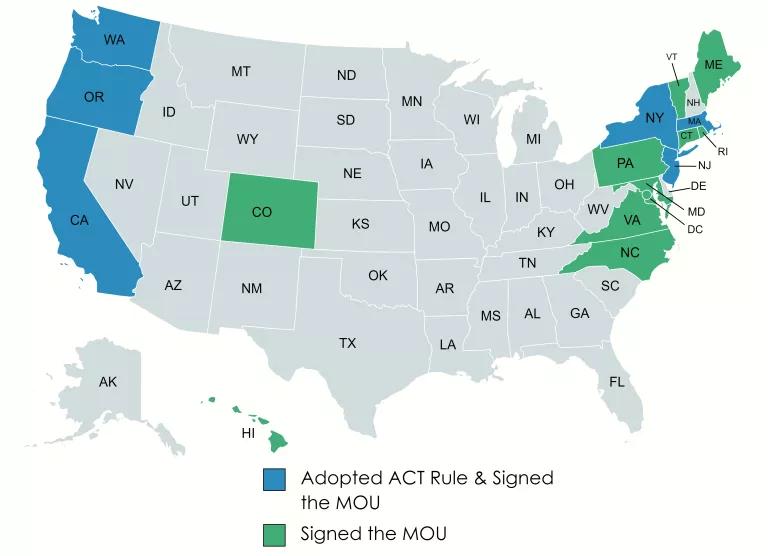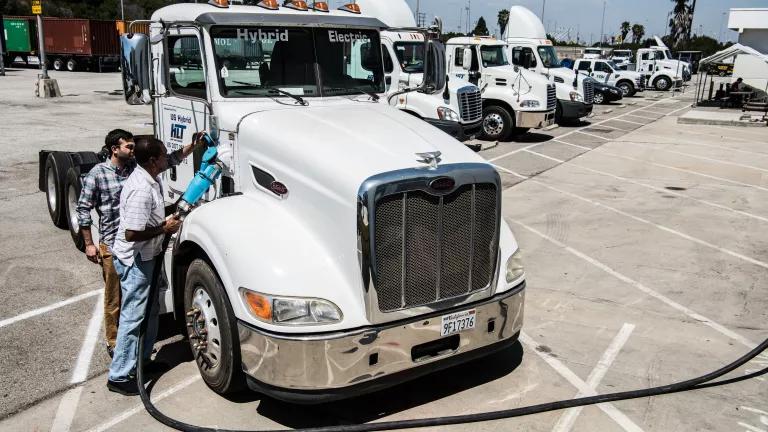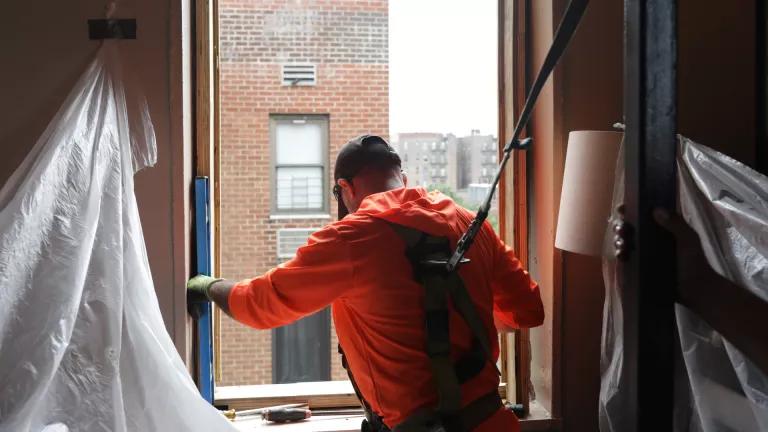EPA: It’s Time to Act. We need Clean Trucks Now
Cutting tailpipe emissions and moving to zero emission vehicles can eliminate the diesel fumes causing childhood asthma, emergency room visits, and loss of life.

Photo by Josiah Farrow on Unsplash
Dirty diesel trucks are a menace to our health. With upcoming standards, the Environmental Protection Agency has a historic opportunity to slash air pollution, protect those in environmental justice communities, and address the climate crisis.
The EPA’s Clean Trucks Plan includes exhaust standards on smog-forming nitrogen oxide (NOx) and particulate matter (PM) and improvements in the existing greenhouse gas standards to incorporate growing availability of zero-emission vehicle technology.
These rules could not be more important. Although less than 10% of vehicles on the road, trucks pump out the majority of hazardous air pollutants and nearly 25% of the transportation sector’s greenhouse gases. This is an urgent public health crisis across the country, particularly for communities near highways, warehouses, and ports. It’s the poorest and most underserved among us who bear a disproportionate share of truck pollution and the resultant health impacts, including asthma, cancer, and premature death.
This is a pivotal opportunity for the Biden administration to eliminate diesel pollution from trucks—something environmental justice communities have been calling for decades. With 16 states, committing to zero-out new truck emissions by 2050, the industry moving quickly to deploy new technologies and the lifetime costs of an electric vehicle often less than that of a diesel, the time is now to lock in progress and ensure these dirty dinosaurs are pushed to extinction.
To save lives and deliver for those most at risk, the upcoming standards must prioritize emission reduction benefits in environmental justice communities and include at least three elements:
- requirement that all truck and bus sales are zero-emitting by 2035;
- an air pollution standard on new diesel vehicles that is at least as protective as existing state requirements; and
- elimination of incentives for false solutions such as methane gas vehicles.
Many states are already acting to spur electric truck sales and slash dangerous air pollution; it’s up to the federal government to accelerate this progress along. Baseless opposition should not derail commonsense efforts to protect public health.
This is a matter of life and death. Cutting tailpipe emissions and moving to zero emission vehicles can eliminate the diesel fumes causing childhood asthma, emergency room visits, and loss of life. The solutions exist and we can’t wait any longer to get there.
Justice delayed is justice denied
In a recent letter to EPA, the Moving Forward Network (MFN), a national coalition of environmental justice groups, called on the Biden administration to address the public health crisis facing communities across the country who are exposed to diesel pollution from trucks serving ports, highways, warehouses, railyards, and freight corridors. The letter says the administration must clean up all freight pollution– from diesel-spewing trucks, to locomotives, to cargo handling equipment, to ships– while shifting to zero emission operations.

Photo by Joey Zanotti on Flickr
Transitioning to zero emission trucks is critical to public health, and must be achieved in tandem with cleaning up combustion engine pollution. Communities have choked on diesel pollution for far too long. They needed relief yesterday.
Surging e-commerce volumes and increases in diesel-spewing truck, ship, and train activity are now magnifying these impacts and heightening the stakes for frontline communities. The Ports of Los Angeles and Long Beach saw their busiest years on record in 2021, and simultaneously, skyrocketing pollution. And the same people chronically harmed by the movement of goods have been decimated by COVID-19.
Zero-emissions by 2035
Six states—California, Massachusetts, New Jersey, New York, Oregon, Washington—have adopted the Advanced Clean Trucks rule, requiring truck makers sell an increasing number of clean, zero-emission trucks. These states are home to 20% of the U.S. medium- and heavy-duty fleet. Another dozen states plan to adopt the zero-emission truck sales requirement this year or next. Because states must give truck makers two years notice to prepare for the rule, the state rules will either start before the EPA’s Clean Trucks Plan in 2027 or the same year it begins.

State Clean Truck Actions
EPA’s Clean Trucks Plan must account for and augment state actions to hasten the positive impact they are having on the market. For example, likely encouraged by state requirements, Daimler, NextEra Energy, and BlackRock agreed to spend over $650 million to build truck charging stations nationwide. These types of investments are becoming a monthly occurrence.
Over in Europe, a joint statement by major truck makers set a 2040 date for 100% zero-emission vehicle sales. On top of that, a trade association representing truck manufacturers is on the record identifying 100% ZEV sales dates for certain truck and bus categories beginning in 2023.
And fleets want these zero-emission trucks. A recent survey of major commercial fleets in the U.S., found overwhelming demand for ZEVs and large purchases expected through 2025—availability permitting.
Clearly this is a dynamic time. All these activities demonstrate that a 100% zero emission truck sales requirement by 2035 is feasible and the direction the industry is already heading. EPA’s Clean Truck Plan must factor in this dynamism and accelerate the transition that is underway.
Protective air pollution standards
In addition to accelerating the transition to zero-emission vehicles, the federal standard should cut NOx pollution from new diesel trucks by at least 90%. Already, California, Oregon, and Massachusetts have adopted a 90% NOx reduction standard called the Heavy-Duty Omnibus rule and more states are expected to follow this year. The Heavy-Duty Omnibus rule also includes a new PM emission standard, extended warranty and useful life requirements, and enhanced testing to better reflect real-world use. As California proved through its seven-year process to develop the rule, the technology required to meet the new requirements is feasible and cost-effective.

California Air Resources Board emission testing facility in Riverside.
Eliminate false solutions
EPA’s Clean Trucks Plan can improve upon state action by removing early action credits that may incentivize methane gas vehicles.
Methane gas is an antiquated solution that should no longer be supported. It will perpetuate our reliance on fossil fuels, result in stranded assets, and increase pollution that affects the climate and the health of frontline communities. According to a study by the ICCT, on average, methane gas vehicles are more harmful to the climate than diesel trucks.
Baseless opposition claims
Change is hard, and some are trying hard to keep dirty trucks on the road.
Many diesel truck manufacturers are claiming that the cost of cleaning up trucks is prohibitive. However, the only cost data they can point to comes from an unverifiable survey conducted on their members with wildly inflated projections. In contrast, numerous third parties, including the California Air Resources Board, have published extensive cost projections that are orders of magnitude less than the industry survey. Moreover, one demonstration project even developed an engine that dramatically reduces emissions and cuts costs.
Manufacturers also argue that the new rules will encourage fleets to buy polluting vehicles before more stringent engine requirements go into effect. But they have no proof for this. A rigorous evaluation shows that in the past, purchasing changes were extremely short-lived and largely influenced by the economy and oil prices.
And the benefits to buying cleaner trucks are huge! Manufacturers will have to build trucks that are tougher and can last longer without breaking. And, if parts do break early, the manufacturer will have to cover those cost. What this does is shift operational repair risks from fleets and individual drivers, to global manufacturers who are best suited to address design issues with their products.
Manufacturers’ claims about high costs and changes to purchasing behavior are entirely unwarranted and unjustified. However, additional complementary policies are needed to ensure the burden of transitioning to cleaner technology doesn’t fall on the backs of drivers.
Next steps
The first phase of the Clean Trucks Plan has already begun with an extensive stakeholder review process overseen by the Office of Management and Budget. However, things start in earnest once EPA publicly proposes a rule, which could come any day. During the rulemaking, the public and interested parties will have an opportunity to make the case for the strongest rules possible.
In the meantime, you can join our partners at the Moving Forward Network in telling EPA to seize the moment by issuing a strong, lifesaving regulation that cleans up tailpipe pollution and spurs the innovation we need.


